University Health Report: Opioid Abuse in Chronic Pain Patients
VerifiedAdded on 2022/08/20
|9
|2170
|13
Report
AI Summary
This report focuses on the critical health issue of opioid abuse among chronic pain patients, aiming to promote effective interventions and health policies. It begins by highlighting the objectives of Healthy People 2020 and selecting opioid abuse as a key health topic, particularly concerning prescription medication misuse. The report targets chronic pain patients and proposes community-based settings, specifically in West Virginia, as ideal for intervention plans. The role of family nurse practitioners (FNPs) in administering opioids and implementing risk mitigation practices is emphasized. A theoretical framework is presented, outlining a patient assessment and intervention process, including risk assessment, patient education, and addiction interventions. The literature review explores the opioid epidemic, advocating for opioid tapering, Mindfulness-Oriented Recovery Enhancement (MORE), and precautionary interventions such as risk assessments and screening tools. It also discusses therapeutic approaches, alternative therapies, and the use of abuse-deterrent formulations. The intervention plan involves assessing patients, implementing risk-based interventions, and providing patient education and support groups. The intended outcomes include reducing opioid-related deaths and prescriptions, drawing parallels with the success of Project Lazarus. In conclusion, the report emphasizes the need for multifaceted interventions to address opioid abuse in chronic pain patients.
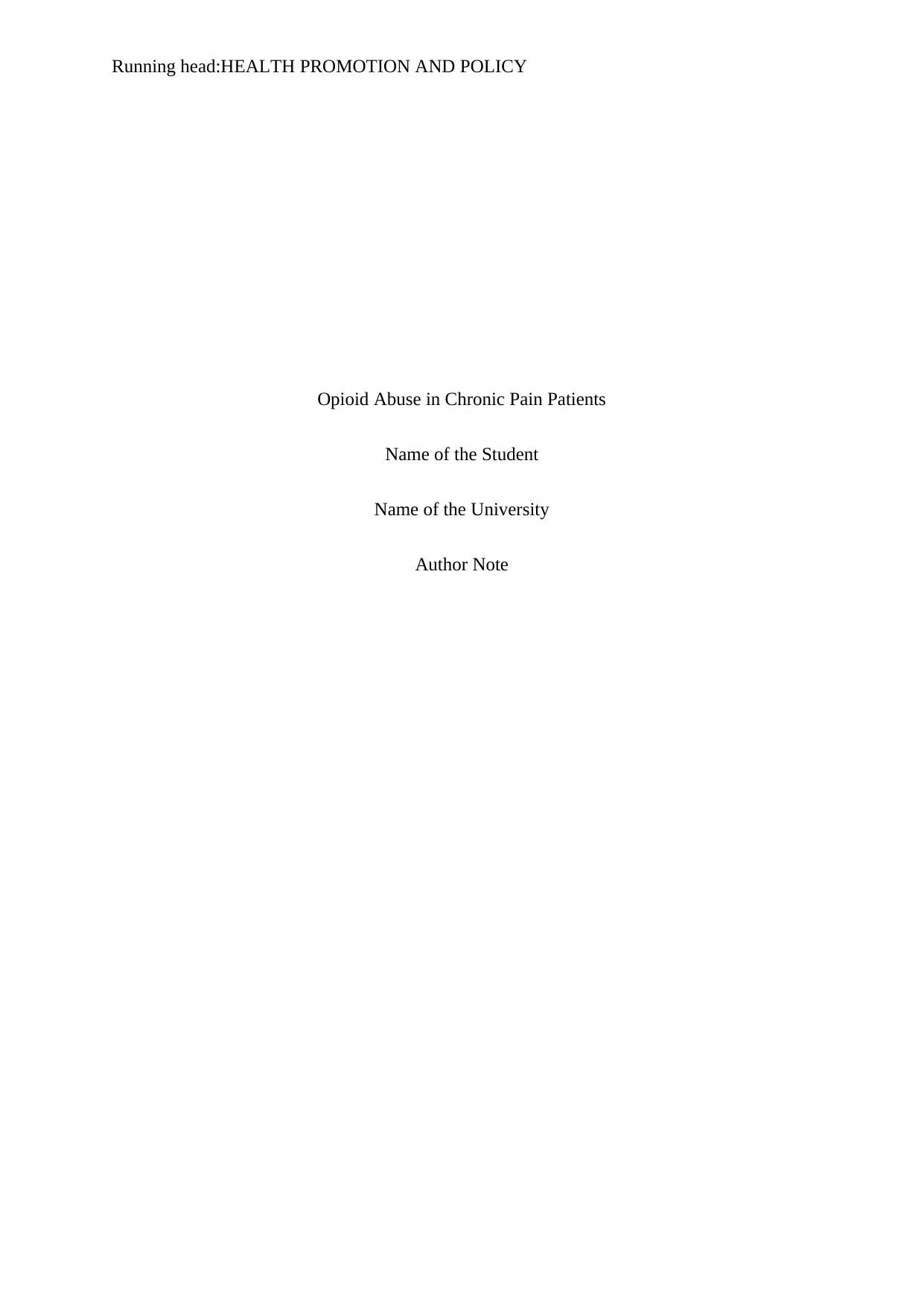
Running head:HEALTH PROMOTION AND POLICY
Opioid Abuse in Chronic Pain Patients
Name of the Student
Name of the University
Author Note
Opioid Abuse in Chronic Pain Patients
Name of the Student
Name of the University
Author Note
Paraphrase This Document
Need a fresh take? Get an instant paraphrase of this document with our AI Paraphraser
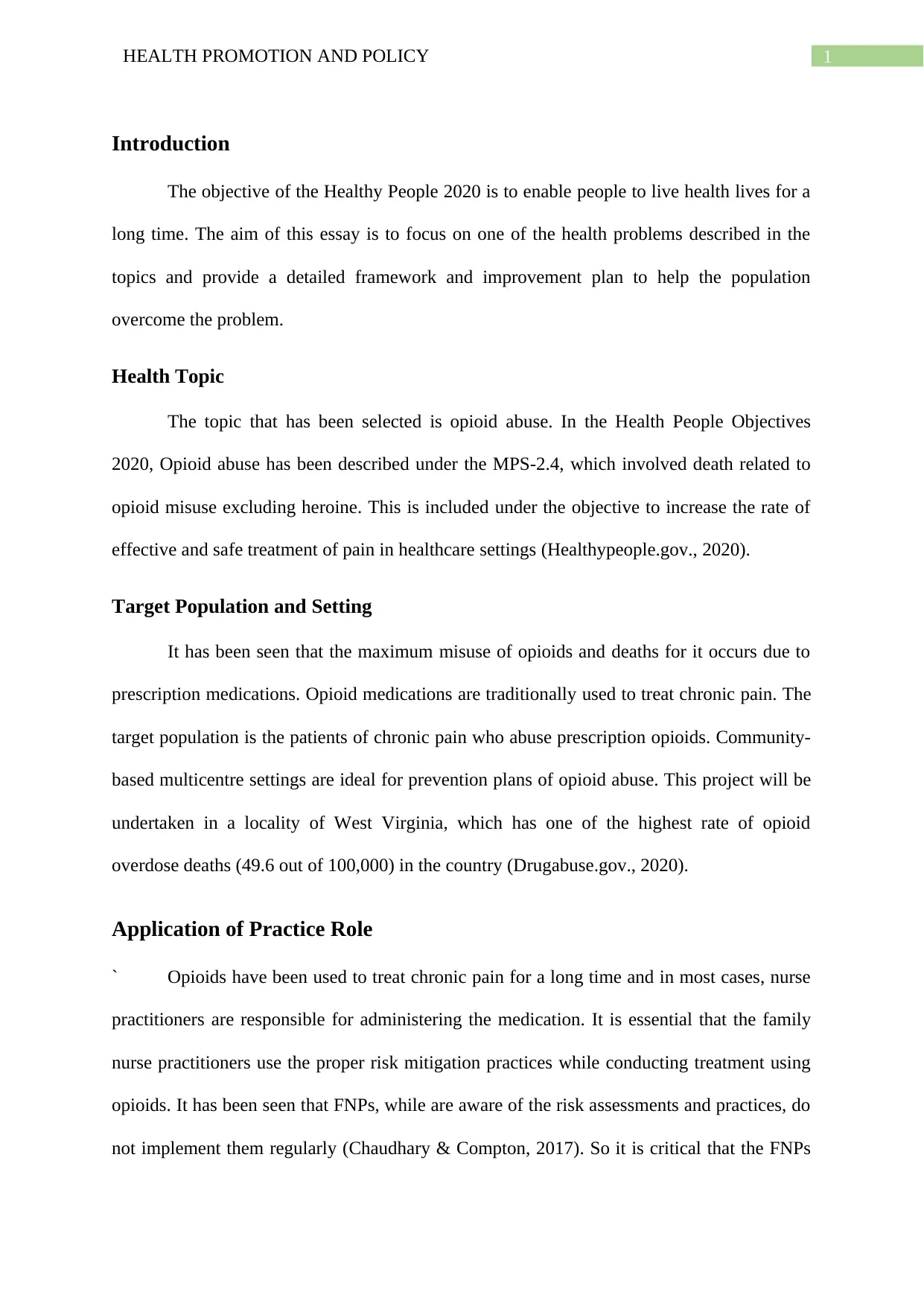
1HEALTH PROMOTION AND POLICY
Introduction
The objective of the Healthy People 2020 is to enable people to live health lives for a
long time. The aim of this essay is to focus on one of the health problems described in the
topics and provide a detailed framework and improvement plan to help the population
overcome the problem.
Health Topic
The topic that has been selected is opioid abuse. In the Health People Objectives
2020, Opioid abuse has been described under the MPS-2.4, which involved death related to
opioid misuse excluding heroine. This is included under the objective to increase the rate of
effective and safe treatment of pain in healthcare settings (Healthypeople.gov., 2020).
Target Population and Setting
It has been seen that the maximum misuse of opioids and deaths for it occurs due to
prescription medications. Opioid medications are traditionally used to treat chronic pain. The
target population is the patients of chronic pain who abuse prescription opioids. Community-
based multicentre settings are ideal for prevention plans of opioid abuse. This project will be
undertaken in a locality of West Virginia, which has one of the highest rate of opioid
overdose deaths (49.6 out of 100,000) in the country (Drugabuse.gov., 2020).
Application of Practice Role
` Opioids have been used to treat chronic pain for a long time and in most cases, nurse
practitioners are responsible for administering the medication. It is essential that the family
nurse practitioners use the proper risk mitigation practices while conducting treatment using
opioids. It has been seen that FNPs, while are aware of the risk assessments and practices, do
not implement them regularly (Chaudhary & Compton, 2017). So it is critical that the FNPs
Introduction
The objective of the Healthy People 2020 is to enable people to live health lives for a
long time. The aim of this essay is to focus on one of the health problems described in the
topics and provide a detailed framework and improvement plan to help the population
overcome the problem.
Health Topic
The topic that has been selected is opioid abuse. In the Health People Objectives
2020, Opioid abuse has been described under the MPS-2.4, which involved death related to
opioid misuse excluding heroine. This is included under the objective to increase the rate of
effective and safe treatment of pain in healthcare settings (Healthypeople.gov., 2020).
Target Population and Setting
It has been seen that the maximum misuse of opioids and deaths for it occurs due to
prescription medications. Opioid medications are traditionally used to treat chronic pain. The
target population is the patients of chronic pain who abuse prescription opioids. Community-
based multicentre settings are ideal for prevention plans of opioid abuse. This project will be
undertaken in a locality of West Virginia, which has one of the highest rate of opioid
overdose deaths (49.6 out of 100,000) in the country (Drugabuse.gov., 2020).
Application of Practice Role
` Opioids have been used to treat chronic pain for a long time and in most cases, nurse
practitioners are responsible for administering the medication. It is essential that the family
nurse practitioners use the proper risk mitigation practices while conducting treatment using
opioids. It has been seen that FNPs, while are aware of the risk assessments and practices, do
not implement them regularly (Chaudhary & Compton, 2017). So it is critical that the FNPs
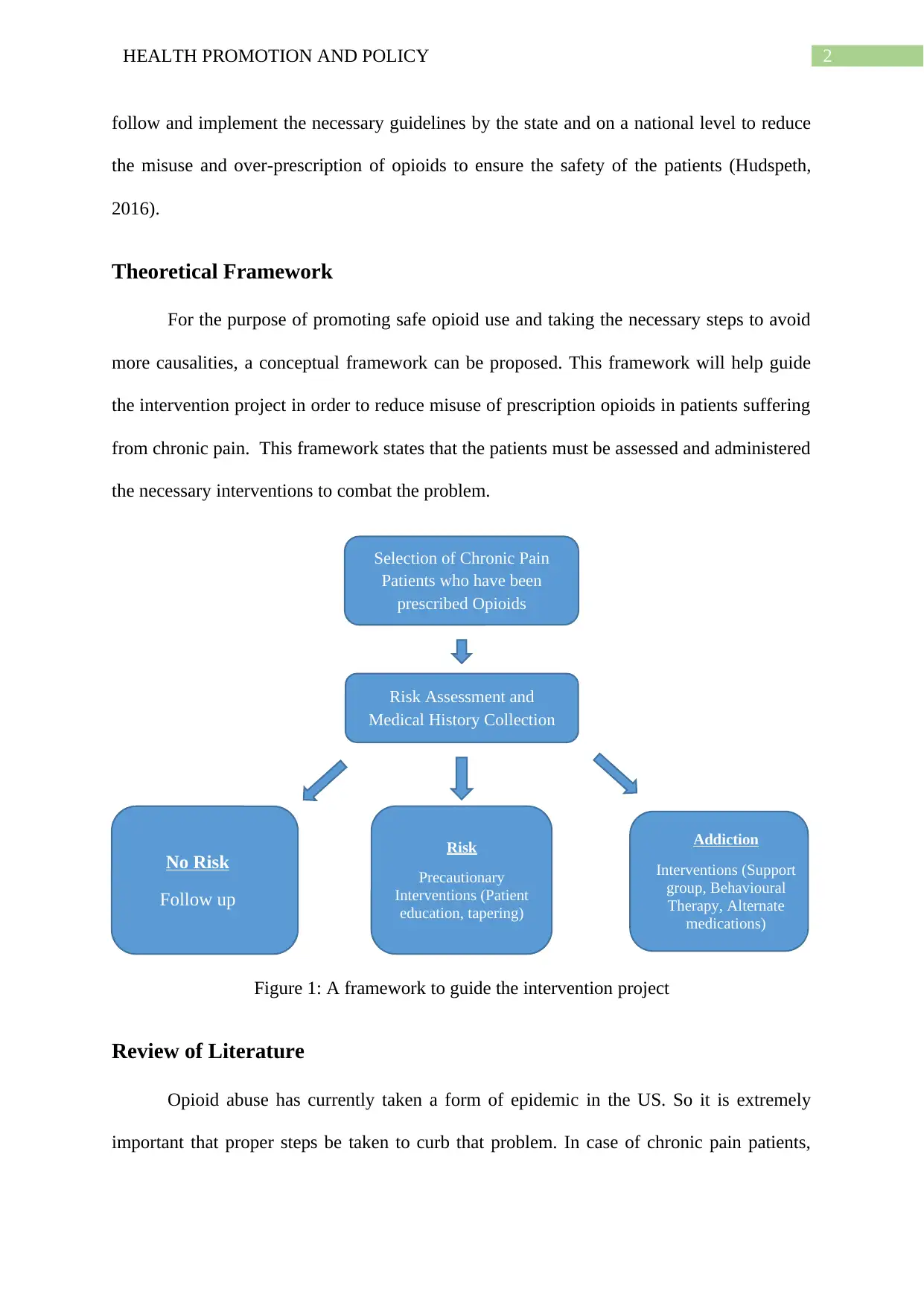
2HEALTH PROMOTION AND POLICY
follow and implement the necessary guidelines by the state and on a national level to reduce
the misuse and over-prescription of opioids to ensure the safety of the patients (Hudspeth,
2016).
Theoretical Framework
For the purpose of promoting safe opioid use and taking the necessary steps to avoid
more causalities, a conceptual framework can be proposed. This framework will help guide
the intervention project in order to reduce misuse of prescription opioids in patients suffering
from chronic pain. This framework states that the patients must be assessed and administered
the necessary interventions to combat the problem.
Figure 1: A framework to guide the intervention project
Review of Literature
Opioid abuse has currently taken a form of epidemic in the US. So it is extremely
important that proper steps be taken to curb that problem. In case of chronic pain patients,
Selection of Chronic Pain
Patients who have been
prescribed Opioids
Risk Assessment and
Medical History Collection
No Risk
Follow up
Risk
Precautionary
Interventions (Patient
education, tapering)
Addiction
Interventions (Support
group, Behavioural
Therapy, Alternate
medications)
follow and implement the necessary guidelines by the state and on a national level to reduce
the misuse and over-prescription of opioids to ensure the safety of the patients (Hudspeth,
2016).
Theoretical Framework
For the purpose of promoting safe opioid use and taking the necessary steps to avoid
more causalities, a conceptual framework can be proposed. This framework will help guide
the intervention project in order to reduce misuse of prescription opioids in patients suffering
from chronic pain. This framework states that the patients must be assessed and administered
the necessary interventions to combat the problem.
Figure 1: A framework to guide the intervention project
Review of Literature
Opioid abuse has currently taken a form of epidemic in the US. So it is extremely
important that proper steps be taken to curb that problem. In case of chronic pain patients,
Selection of Chronic Pain
Patients who have been
prescribed Opioids
Risk Assessment and
Medical History Collection
No Risk
Follow up
Risk
Precautionary
Interventions (Patient
education, tapering)
Addiction
Interventions (Support
group, Behavioural
Therapy, Alternate
medications)
⊘ This is a preview!⊘
Do you want full access?
Subscribe today to unlock all pages.

Trusted by 1+ million students worldwide
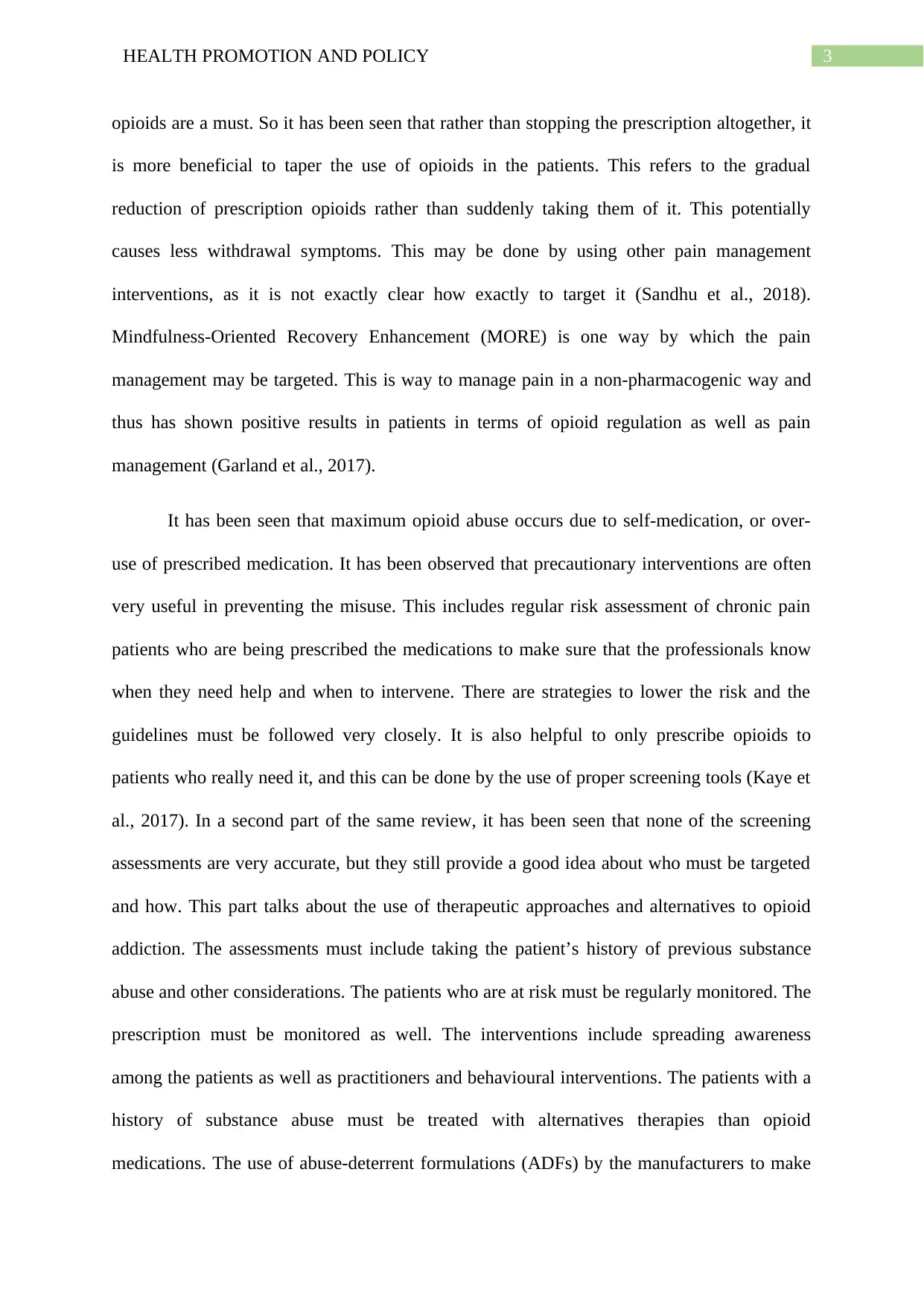
3HEALTH PROMOTION AND POLICY
opioids are a must. So it has been seen that rather than stopping the prescription altogether, it
is more beneficial to taper the use of opioids in the patients. This refers to the gradual
reduction of prescription opioids rather than suddenly taking them of it. This potentially
causes less withdrawal symptoms. This may be done by using other pain management
interventions, as it is not exactly clear how exactly to target it (Sandhu et al., 2018).
Mindfulness-Oriented Recovery Enhancement (MORE) is one way by which the pain
management may be targeted. This is way to manage pain in a non-pharmacogenic way and
thus has shown positive results in patients in terms of opioid regulation as well as pain
management (Garland et al., 2017).
It has been seen that maximum opioid abuse occurs due to self-medication, or over-
use of prescribed medication. It has been observed that precautionary interventions are often
very useful in preventing the misuse. This includes regular risk assessment of chronic pain
patients who are being prescribed the medications to make sure that the professionals know
when they need help and when to intervene. There are strategies to lower the risk and the
guidelines must be followed very closely. It is also helpful to only prescribe opioids to
patients who really need it, and this can be done by the use of proper screening tools (Kaye et
al., 2017). In a second part of the same review, it has been seen that none of the screening
assessments are very accurate, but they still provide a good idea about who must be targeted
and how. This part talks about the use of therapeutic approaches and alternatives to opioid
addiction. The assessments must include taking the patient’s history of previous substance
abuse and other considerations. The patients who are at risk must be regularly monitored. The
prescription must be monitored as well. The interventions include spreading awareness
among the patients as well as practitioners and behavioural interventions. The patients with a
history of substance abuse must be treated with alternatives therapies than opioid
medications. The use of abuse-deterrent formulations (ADFs) by the manufacturers to make
opioids are a must. So it has been seen that rather than stopping the prescription altogether, it
is more beneficial to taper the use of opioids in the patients. This refers to the gradual
reduction of prescription opioids rather than suddenly taking them of it. This potentially
causes less withdrawal symptoms. This may be done by using other pain management
interventions, as it is not exactly clear how exactly to target it (Sandhu et al., 2018).
Mindfulness-Oriented Recovery Enhancement (MORE) is one way by which the pain
management may be targeted. This is way to manage pain in a non-pharmacogenic way and
thus has shown positive results in patients in terms of opioid regulation as well as pain
management (Garland et al., 2017).
It has been seen that maximum opioid abuse occurs due to self-medication, or over-
use of prescribed medication. It has been observed that precautionary interventions are often
very useful in preventing the misuse. This includes regular risk assessment of chronic pain
patients who are being prescribed the medications to make sure that the professionals know
when they need help and when to intervene. There are strategies to lower the risk and the
guidelines must be followed very closely. It is also helpful to only prescribe opioids to
patients who really need it, and this can be done by the use of proper screening tools (Kaye et
al., 2017). In a second part of the same review, it has been seen that none of the screening
assessments are very accurate, but they still provide a good idea about who must be targeted
and how. This part talks about the use of therapeutic approaches and alternatives to opioid
addiction. The assessments must include taking the patient’s history of previous substance
abuse and other considerations. The patients who are at risk must be regularly monitored. The
prescription must be monitored as well. The interventions include spreading awareness
among the patients as well as practitioners and behavioural interventions. The patients with a
history of substance abuse must be treated with alternatives therapies than opioid
medications. The use of abuse-deterrent formulations (ADFs) by the manufacturers to make
Paraphrase This Document
Need a fresh take? Get an instant paraphrase of this document with our AI Paraphraser
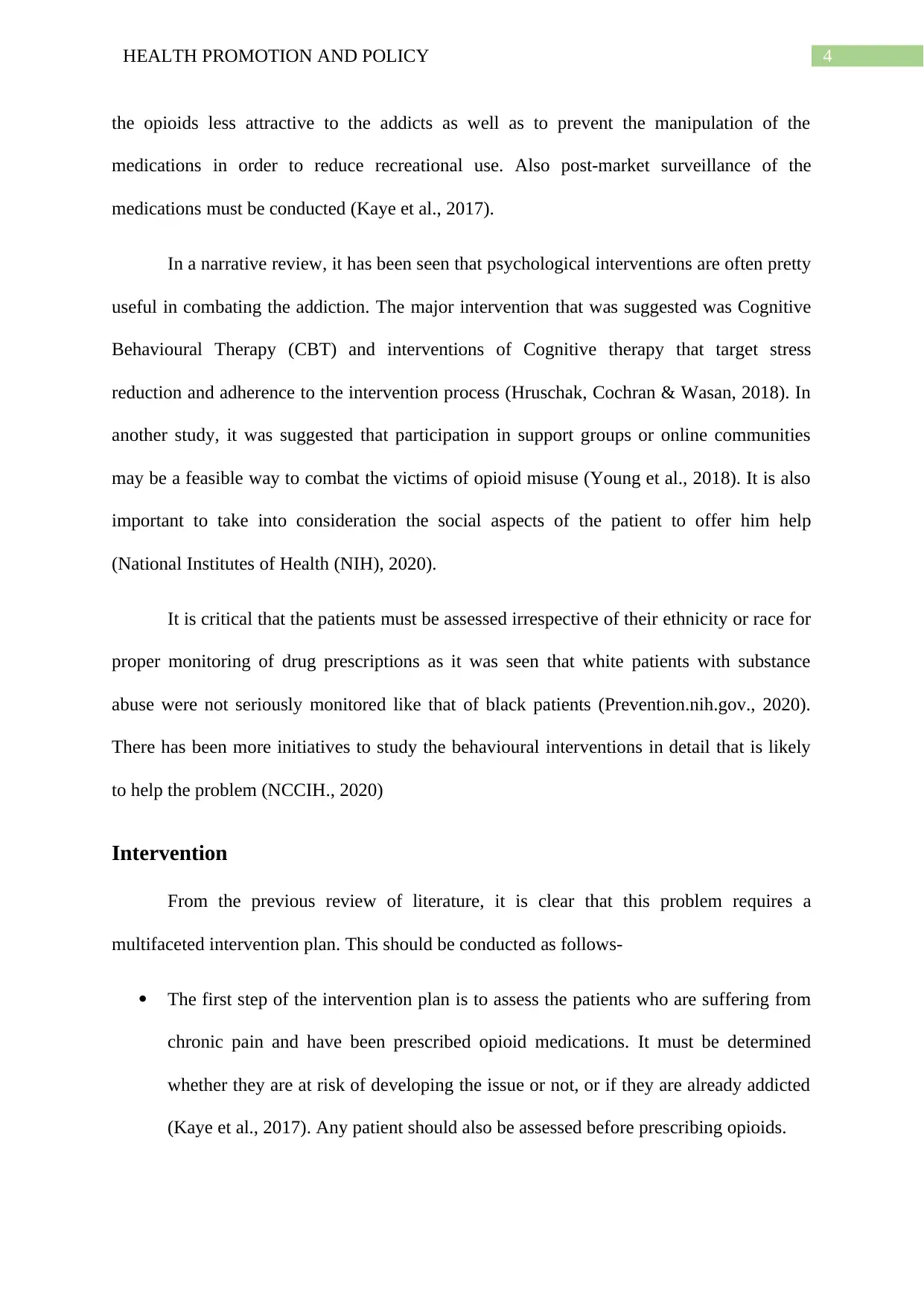
4HEALTH PROMOTION AND POLICY
the opioids less attractive to the addicts as well as to prevent the manipulation of the
medications in order to reduce recreational use. Also post-market surveillance of the
medications must be conducted (Kaye et al., 2017).
In a narrative review, it has been seen that psychological interventions are often pretty
useful in combating the addiction. The major intervention that was suggested was Cognitive
Behavioural Therapy (CBT) and interventions of Cognitive therapy that target stress
reduction and adherence to the intervention process (Hruschak, Cochran & Wasan, 2018). In
another study, it was suggested that participation in support groups or online communities
may be a feasible way to combat the victims of opioid misuse (Young et al., 2018). It is also
important to take into consideration the social aspects of the patient to offer him help
(National Institutes of Health (NIH), 2020).
It is critical that the patients must be assessed irrespective of their ethnicity or race for
proper monitoring of drug prescriptions as it was seen that white patients with substance
abuse were not seriously monitored like that of black patients (Prevention.nih.gov., 2020).
There has been more initiatives to study the behavioural interventions in detail that is likely
to help the problem (NCCIH., 2020)
Intervention
From the previous review of literature, it is clear that this problem requires a
multifaceted intervention plan. This should be conducted as follows-
The first step of the intervention plan is to assess the patients who are suffering from
chronic pain and have been prescribed opioid medications. It must be determined
whether they are at risk of developing the issue or not, or if they are already addicted
(Kaye et al., 2017). Any patient should also be assessed before prescribing opioids.
the opioids less attractive to the addicts as well as to prevent the manipulation of the
medications in order to reduce recreational use. Also post-market surveillance of the
medications must be conducted (Kaye et al., 2017).
In a narrative review, it has been seen that psychological interventions are often pretty
useful in combating the addiction. The major intervention that was suggested was Cognitive
Behavioural Therapy (CBT) and interventions of Cognitive therapy that target stress
reduction and adherence to the intervention process (Hruschak, Cochran & Wasan, 2018). In
another study, it was suggested that participation in support groups or online communities
may be a feasible way to combat the victims of opioid misuse (Young et al., 2018). It is also
important to take into consideration the social aspects of the patient to offer him help
(National Institutes of Health (NIH), 2020).
It is critical that the patients must be assessed irrespective of their ethnicity or race for
proper monitoring of drug prescriptions as it was seen that white patients with substance
abuse were not seriously monitored like that of black patients (Prevention.nih.gov., 2020).
There has been more initiatives to study the behavioural interventions in detail that is likely
to help the problem (NCCIH., 2020)
Intervention
From the previous review of literature, it is clear that this problem requires a
multifaceted intervention plan. This should be conducted as follows-
The first step of the intervention plan is to assess the patients who are suffering from
chronic pain and have been prescribed opioid medications. It must be determined
whether they are at risk of developing the issue or not, or if they are already addicted
(Kaye et al., 2017). Any patient should also be assessed before prescribing opioids.
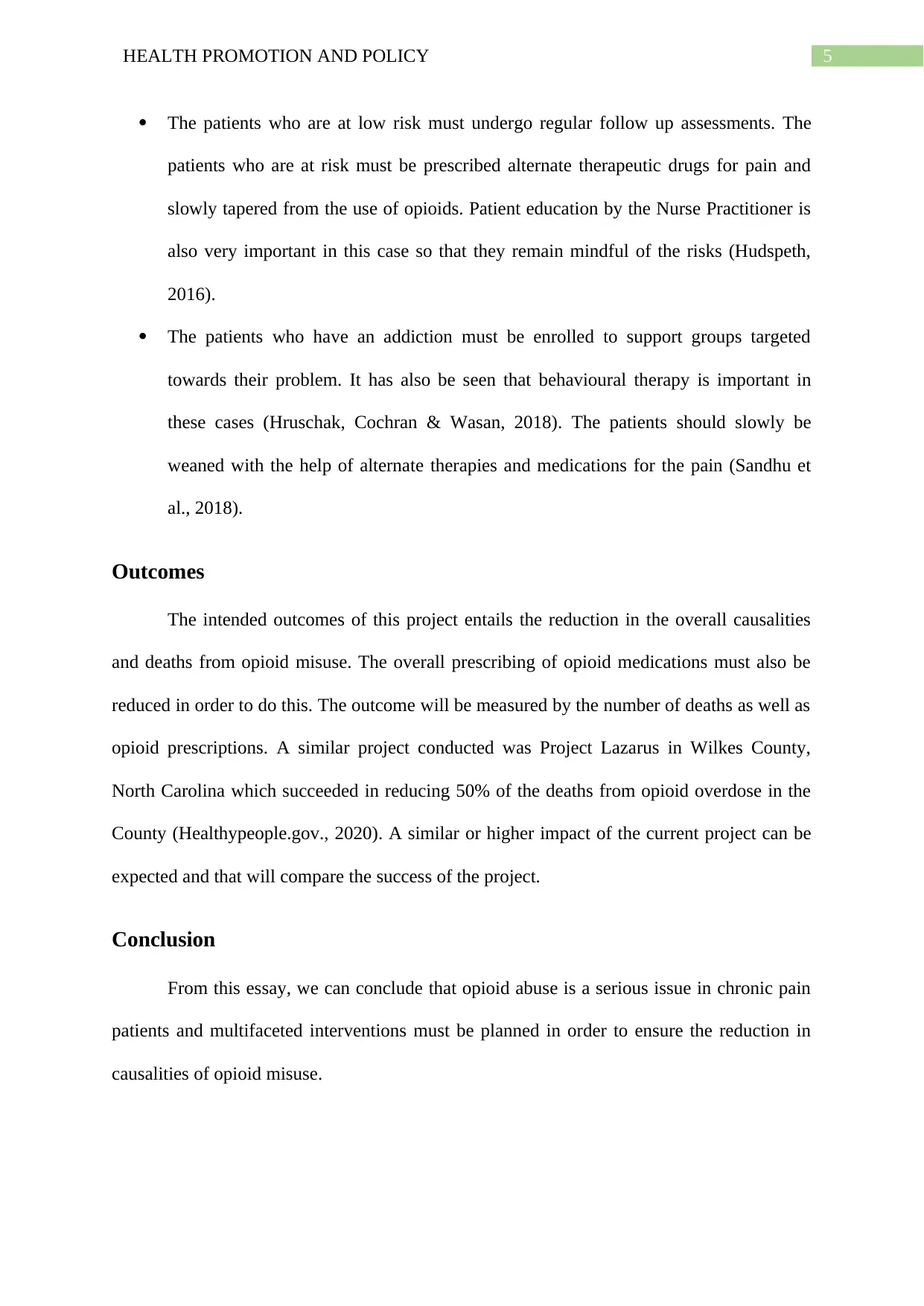
5HEALTH PROMOTION AND POLICY
The patients who are at low risk must undergo regular follow up assessments. The
patients who are at risk must be prescribed alternate therapeutic drugs for pain and
slowly tapered from the use of opioids. Patient education by the Nurse Practitioner is
also very important in this case so that they remain mindful of the risks (Hudspeth,
2016).
The patients who have an addiction must be enrolled to support groups targeted
towards their problem. It has also be seen that behavioural therapy is important in
these cases (Hruschak, Cochran & Wasan, 2018). The patients should slowly be
weaned with the help of alternate therapies and medications for the pain (Sandhu et
al., 2018).
Outcomes
The intended outcomes of this project entails the reduction in the overall causalities
and deaths from opioid misuse. The overall prescribing of opioid medications must also be
reduced in order to do this. The outcome will be measured by the number of deaths as well as
opioid prescriptions. A similar project conducted was Project Lazarus in Wilkes County,
North Carolina which succeeded in reducing 50% of the deaths from opioid overdose in the
County (Healthypeople.gov., 2020). A similar or higher impact of the current project can be
expected and that will compare the success of the project.
Conclusion
From this essay, we can conclude that opioid abuse is a serious issue in chronic pain
patients and multifaceted interventions must be planned in order to ensure the reduction in
causalities of opioid misuse.
The patients who are at low risk must undergo regular follow up assessments. The
patients who are at risk must be prescribed alternate therapeutic drugs for pain and
slowly tapered from the use of opioids. Patient education by the Nurse Practitioner is
also very important in this case so that they remain mindful of the risks (Hudspeth,
2016).
The patients who have an addiction must be enrolled to support groups targeted
towards their problem. It has also be seen that behavioural therapy is important in
these cases (Hruschak, Cochran & Wasan, 2018). The patients should slowly be
weaned with the help of alternate therapies and medications for the pain (Sandhu et
al., 2018).
Outcomes
The intended outcomes of this project entails the reduction in the overall causalities
and deaths from opioid misuse. The overall prescribing of opioid medications must also be
reduced in order to do this. The outcome will be measured by the number of deaths as well as
opioid prescriptions. A similar project conducted was Project Lazarus in Wilkes County,
North Carolina which succeeded in reducing 50% of the deaths from opioid overdose in the
County (Healthypeople.gov., 2020). A similar or higher impact of the current project can be
expected and that will compare the success of the project.
Conclusion
From this essay, we can conclude that opioid abuse is a serious issue in chronic pain
patients and multifaceted interventions must be planned in order to ensure the reduction in
causalities of opioid misuse.
⊘ This is a preview!⊘
Do you want full access?
Subscribe today to unlock all pages.

Trusted by 1+ million students worldwide
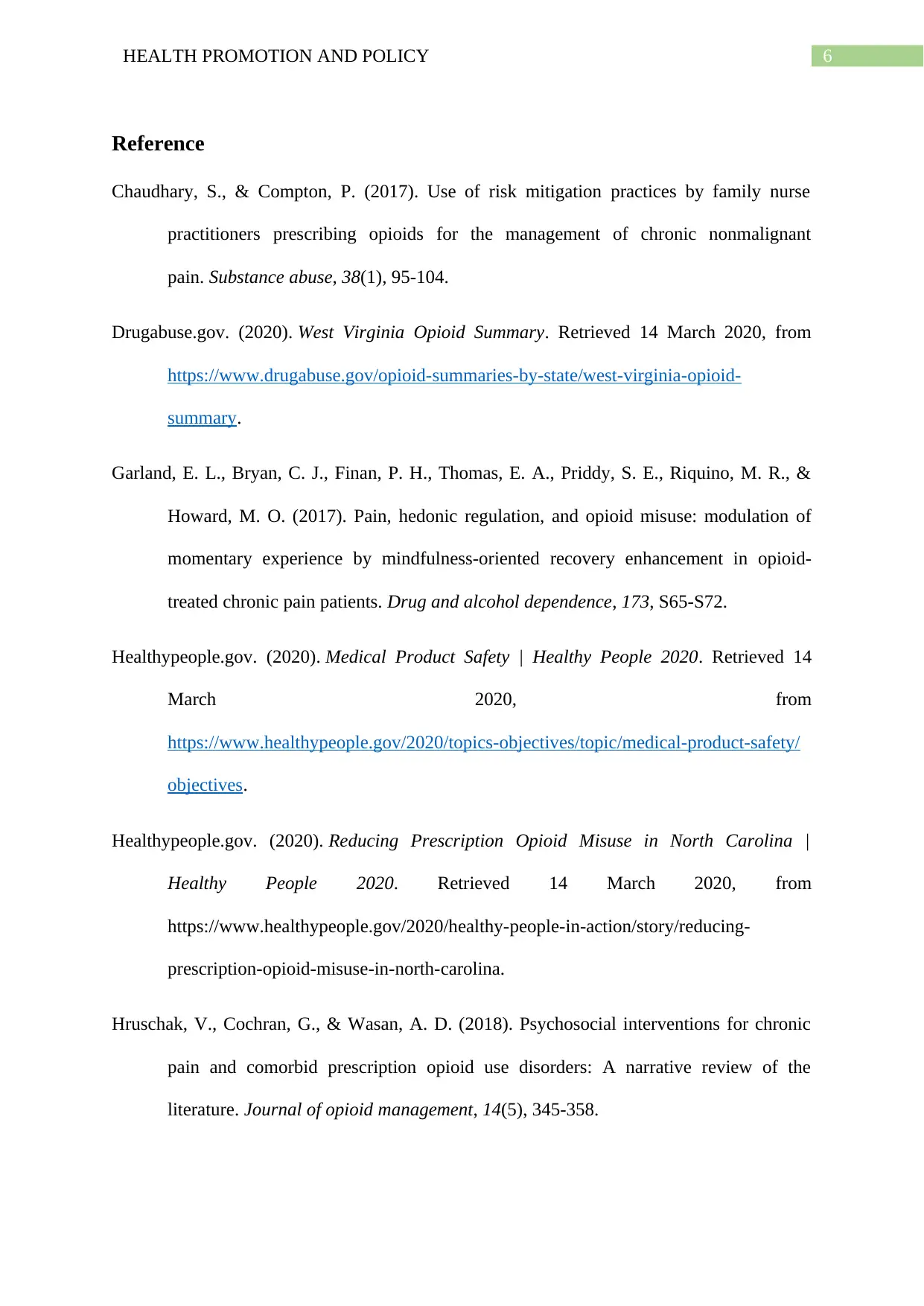
6HEALTH PROMOTION AND POLICY
Reference
Chaudhary, S., & Compton, P. (2017). Use of risk mitigation practices by family nurse
practitioners prescribing opioids for the management of chronic nonmalignant
pain. Substance abuse, 38(1), 95-104.
Drugabuse.gov. (2020). West Virginia Opioid Summary. Retrieved 14 March 2020, from
https://www.drugabuse.gov/opioid-summaries-by-state/west-virginia-opioid-
summary.
Garland, E. L., Bryan, C. J., Finan, P. H., Thomas, E. A., Priddy, S. E., Riquino, M. R., &
Howard, M. O. (2017). Pain, hedonic regulation, and opioid misuse: modulation of
momentary experience by mindfulness-oriented recovery enhancement in opioid-
treated chronic pain patients. Drug and alcohol dependence, 173, S65-S72.
Healthypeople.gov. (2020). Medical Product Safety | Healthy People 2020. Retrieved 14
March 2020, from
https://www.healthypeople.gov/2020/topics-objectives/topic/medical-product-safety/
objectives.
Healthypeople.gov. (2020). Reducing Prescription Opioid Misuse in North Carolina |
Healthy People 2020. Retrieved 14 March 2020, from
https://www.healthypeople.gov/2020/healthy-people-in-action/story/reducing-
prescription-opioid-misuse-in-north-carolina.
Hruschak, V., Cochran, G., & Wasan, A. D. (2018). Psychosocial interventions for chronic
pain and comorbid prescription opioid use disorders: A narrative review of the
literature. Journal of opioid management, 14(5), 345-358.
Reference
Chaudhary, S., & Compton, P. (2017). Use of risk mitigation practices by family nurse
practitioners prescribing opioids for the management of chronic nonmalignant
pain. Substance abuse, 38(1), 95-104.
Drugabuse.gov. (2020). West Virginia Opioid Summary. Retrieved 14 March 2020, from
https://www.drugabuse.gov/opioid-summaries-by-state/west-virginia-opioid-
summary.
Garland, E. L., Bryan, C. J., Finan, P. H., Thomas, E. A., Priddy, S. E., Riquino, M. R., &
Howard, M. O. (2017). Pain, hedonic regulation, and opioid misuse: modulation of
momentary experience by mindfulness-oriented recovery enhancement in opioid-
treated chronic pain patients. Drug and alcohol dependence, 173, S65-S72.
Healthypeople.gov. (2020). Medical Product Safety | Healthy People 2020. Retrieved 14
March 2020, from
https://www.healthypeople.gov/2020/topics-objectives/topic/medical-product-safety/
objectives.
Healthypeople.gov. (2020). Reducing Prescription Opioid Misuse in North Carolina |
Healthy People 2020. Retrieved 14 March 2020, from
https://www.healthypeople.gov/2020/healthy-people-in-action/story/reducing-
prescription-opioid-misuse-in-north-carolina.
Hruschak, V., Cochran, G., & Wasan, A. D. (2018). Psychosocial interventions for chronic
pain and comorbid prescription opioid use disorders: A narrative review of the
literature. Journal of opioid management, 14(5), 345-358.
Paraphrase This Document
Need a fresh take? Get an instant paraphrase of this document with our AI Paraphraser
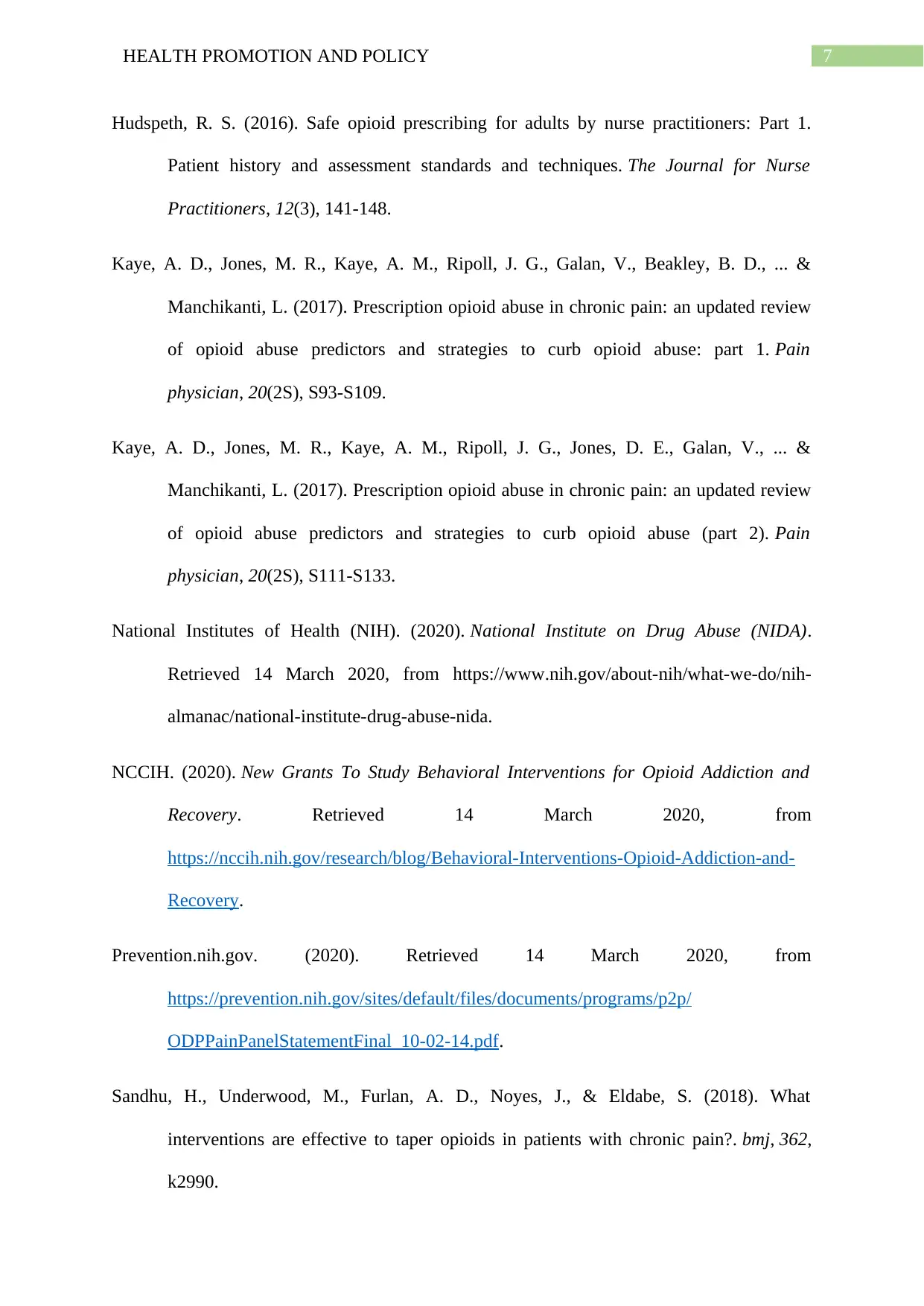
7HEALTH PROMOTION AND POLICY
Hudspeth, R. S. (2016). Safe opioid prescribing for adults by nurse practitioners: Part 1.
Patient history and assessment standards and techniques. The Journal for Nurse
Practitioners, 12(3), 141-148.
Kaye, A. D., Jones, M. R., Kaye, A. M., Ripoll, J. G., Galan, V., Beakley, B. D., ... &
Manchikanti, L. (2017). Prescription opioid abuse in chronic pain: an updated review
of opioid abuse predictors and strategies to curb opioid abuse: part 1. Pain
physician, 20(2S), S93-S109.
Kaye, A. D., Jones, M. R., Kaye, A. M., Ripoll, J. G., Jones, D. E., Galan, V., ... &
Manchikanti, L. (2017). Prescription opioid abuse in chronic pain: an updated review
of opioid abuse predictors and strategies to curb opioid abuse (part 2). Pain
physician, 20(2S), S111-S133.
National Institutes of Health (NIH). (2020). National Institute on Drug Abuse (NIDA).
Retrieved 14 March 2020, from https://www.nih.gov/about-nih/what-we-do/nih-
almanac/national-institute-drug-abuse-nida.
NCCIH. (2020). New Grants To Study Behavioral Interventions for Opioid Addiction and
Recovery. Retrieved 14 March 2020, from
https://nccih.nih.gov/research/blog/Behavioral-Interventions-Opioid-Addiction-and-
Recovery.
Prevention.nih.gov. (2020). Retrieved 14 March 2020, from
https://prevention.nih.gov/sites/default/files/documents/programs/p2p/
ODPPainPanelStatementFinal_10-02-14.pdf.
Sandhu, H., Underwood, M., Furlan, A. D., Noyes, J., & Eldabe, S. (2018). What
interventions are effective to taper opioids in patients with chronic pain?. bmj, 362,
k2990.
Hudspeth, R. S. (2016). Safe opioid prescribing for adults by nurse practitioners: Part 1.
Patient history and assessment standards and techniques. The Journal for Nurse
Practitioners, 12(3), 141-148.
Kaye, A. D., Jones, M. R., Kaye, A. M., Ripoll, J. G., Galan, V., Beakley, B. D., ... &
Manchikanti, L. (2017). Prescription opioid abuse in chronic pain: an updated review
of opioid abuse predictors and strategies to curb opioid abuse: part 1. Pain
physician, 20(2S), S93-S109.
Kaye, A. D., Jones, M. R., Kaye, A. M., Ripoll, J. G., Jones, D. E., Galan, V., ... &
Manchikanti, L. (2017). Prescription opioid abuse in chronic pain: an updated review
of opioid abuse predictors and strategies to curb opioid abuse (part 2). Pain
physician, 20(2S), S111-S133.
National Institutes of Health (NIH). (2020). National Institute on Drug Abuse (NIDA).
Retrieved 14 March 2020, from https://www.nih.gov/about-nih/what-we-do/nih-
almanac/national-institute-drug-abuse-nida.
NCCIH. (2020). New Grants To Study Behavioral Interventions for Opioid Addiction and
Recovery. Retrieved 14 March 2020, from
https://nccih.nih.gov/research/blog/Behavioral-Interventions-Opioid-Addiction-and-
Recovery.
Prevention.nih.gov. (2020). Retrieved 14 March 2020, from
https://prevention.nih.gov/sites/default/files/documents/programs/p2p/
ODPPainPanelStatementFinal_10-02-14.pdf.
Sandhu, H., Underwood, M., Furlan, A. D., Noyes, J., & Eldabe, S. (2018). What
interventions are effective to taper opioids in patients with chronic pain?. bmj, 362,
k2990.
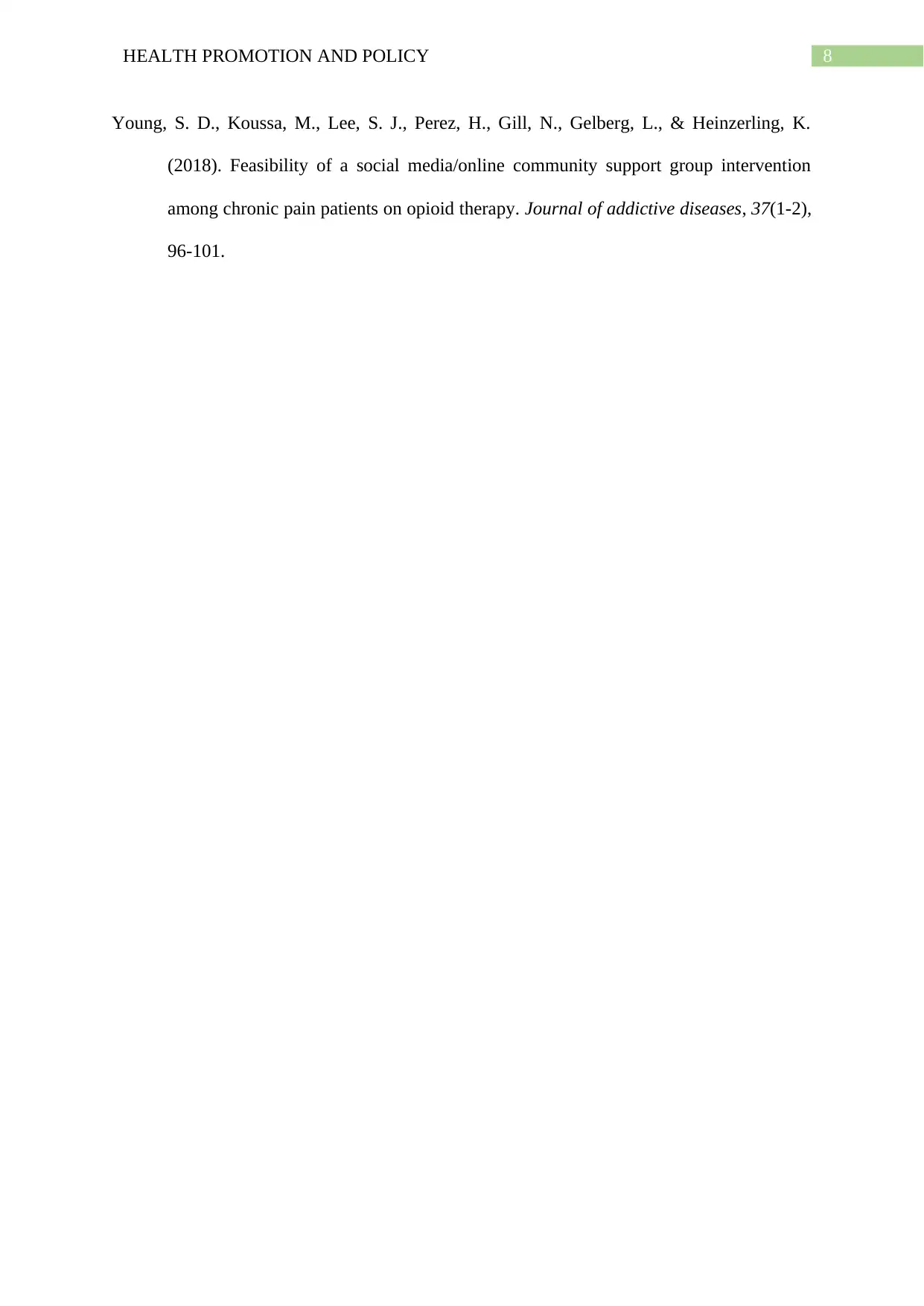
8HEALTH PROMOTION AND POLICY
Young, S. D., Koussa, M., Lee, S. J., Perez, H., Gill, N., Gelberg, L., & Heinzerling, K.
(2018). Feasibility of a social media/online community support group intervention
among chronic pain patients on opioid therapy. Journal of addictive diseases, 37(1-2),
96-101.
Young, S. D., Koussa, M., Lee, S. J., Perez, H., Gill, N., Gelberg, L., & Heinzerling, K.
(2018). Feasibility of a social media/online community support group intervention
among chronic pain patients on opioid therapy. Journal of addictive diseases, 37(1-2),
96-101.
⊘ This is a preview!⊘
Do you want full access?
Subscribe today to unlock all pages.

Trusted by 1+ million students worldwide
1 out of 9
Related Documents
Your All-in-One AI-Powered Toolkit for Academic Success.
+13062052269
info@desklib.com
Available 24*7 on WhatsApp / Email
![[object Object]](/_next/static/media/star-bottom.7253800d.svg)
Unlock your academic potential
Copyright © 2020–2025 A2Z Services. All Rights Reserved. Developed and managed by ZUCOL.





